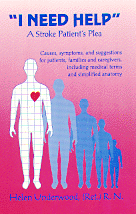 "I Need Help"
"I Need Help" "I Need Help"
"I Need Help"ISBN: 0-931892-72-4, 112 pages, 5.5 x 8.5, paper, $8.95
Having a stroke can be a devastating experience for both the patient and family. The crisis created by a stroke creates an immediate need for the family to understand how to take care of the stroke patient. "Often the family is upset and disoriented, and leaves the doctor's office without remembering or fully comprehending how to respond properly to the stroke patient's needs." After years of nursing experience and teaching nurses' assistants, Helen Underwood has compiled a practical manual for families and caregivers.
Noting the causes and symptoms of a stroke and the methods for assisting the patient, Ms. Underwood then discusses the difference between acute and extended care facilities, reviews simplified anatomy and medical terminology, and includes twelve basic need illustrations to help the caregiver and patient communicate.
|
Endorsements |
"...this will be a helpful handbook for families and health care workers alike who want factual information about stroke (CVA)." Solveig Crawford, RN, PHN, Dept. of Health Services, CA
"...highly recommended for anyone faced with the responsibility of taking care of a stroke patient." William James, M.D.
|
Table of Contents |
Author's Note
Part I: Understanding Stroke
1. Definition of Stroke
2. Causes of Stroke
3. Symptoms of Stroke
4. Assisting the Paralyzed
5. Assisting the Aphasic
6. Suggestions in Summary
Part II: Understanding Geriatrics Introduction
7. The Acute Facility Versus the Extended Care Facility
8. Body Systems
9. Understanding Nuclear Medicine and Diagnostic Procedures
Part III: Understanding Medical Terminology
10. Medical Terminology
Part IV: Basic Needs Illustrations
11. Basic Needs Illustrations
|
Excerpt |
This publication is written to emphasize the importance of better understanding and appropriate response to the frustrations experienced in problems of many patients, primarily paralysis and difficulties in communication in varying degrees (aphasia). As you read, try to visualize yourself personally in a similar situation, realizing that brain damage can occur at any age, at any time.
The suggestions herein have been accumulated by personal experience in caring for hundreds of such patients, as well as having taught many Nursing Assistants over the years.
In order to accurately understand the severe problems of stroke, one must relate on a personal level. Just try to imagine both paralysis and aphasia: You wake up during the night in pain (and possibly some itching), and unable to communicate, let alone respond to either - even to turn over or change your position.